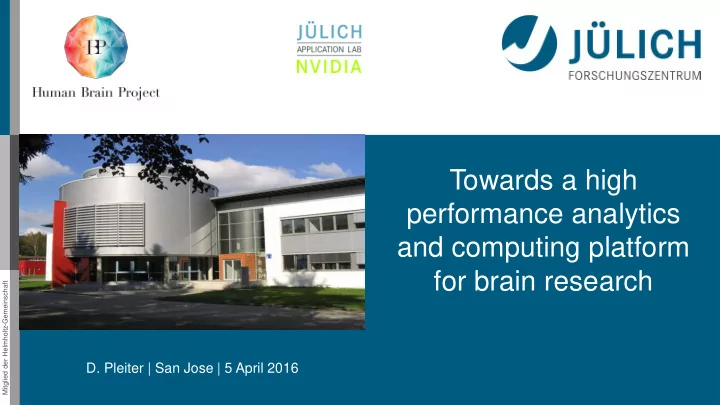

Towards a high performance analytics and computing platform for brain research Mitglied der Helmholtz-Gemeinschaft D. Pleiter | San Jose | 5 April 2016
Overview Introduction to Jülich Supercomputing Centre and Human Brain Project Selected objectives of the Human Brain Project Interactive supercomputing and future supercomputer requirements Conclusions Mitglied der Helmholtz-Gemeinschaft D. Pleiter 2
Jülich Supercomputing Centre Provisioning of HPC infrastructure HPC resources for Regional and national level Europe (PRACE, EU projects) Application support Education and Training Research and development Computational science: SimLab Algorithms, performance analysis and tools Mitglied der Helmholtz-Gemeinschaft HPC architectures and technologies Exascale Laboratories Community data management services D. Pleiter 3
HPC Infrastructure at JSC: Dual Track Concept IBM Power 4+ JUMP, 9 TFlop/s IBM Blue Gene/L IBM Power 6 JUBL, 45 TFlop/s JUMP, 9 TFlop/s IBM Blue Gene/P Intel Nehalem JUGENE, 1 PFlop/s JUROPA 300 TFlop/s IBM Blue Gene/Q JUQUEEN 5.9 PFlop/s Mitglied der Helmholtz-Gemeinschaft Intel Haswell JURECA ~ 2 PFlop/s JUQUEEN successor ~ 50 PFlop/s + Booster ~ 10 PFlop/s General-Purpose Cluster Highly Scalable System D. Pleiter 4
The Human Brain Project Future & Emerging Technologies flagship project (co-)funded by European Commission Science-driven, seeded from FET, extending beyond ICT Ambitious, unifying goal, large-scale Goal To build an integrated ICT infrastructure enabling a global collaborative effort towards understanding the human brain, and ultimately to emulate its computational capabilities HBP sub-projects include: Mitglied der Helmholtz-Gemeinschaft Strategic Human Brain Data (Amunts, Jülich) The Brain Simulation Platform (Markram, EPFL) High Performance Analytics & Computing Platform (Lippert, Jülich) D. Pleiter 5
Objective: High-resolution Brain Atlas Research goal Accurate, highly detailed computer model of the human brain based on histological input Approach Create high-resolution 2- dimensional brain section Mitglied der Helmholtz-Gemeinschaft images Re-construct 3-dimensional [K. Amunts et al., Science 2013] models from these images D. Pleiter 6
Need for High Resolution [Julia Reckfort et al., 2015] Mitglied der Helmholtz-Gemeinschaft Large-Area Polarimeter image Polarizing Microscope image Optical resolution limit = 159 μ m Optical resolution limit = 3.9 μ m ~3 GByte / image ~700 GByte / image D. Pleiter 7
Objective: Brain Simulation using NEST Application target Create models of the brains of mammals and humans Push limits of large-scale simulations of biologically realistic networks Huge network: O(10 11 ) neurons High connectivity: Neuron connected to O(10 4 ) neurons Approach Mitglied der Helmholtz-Gemeinschaft Simulation of spiking neuronal network Focus on large networks, use of simple point neurons [Potjans, Diesmann, 2012] D. Pleiter 8
High Performance Analytics and Computing Platform Heterogeneous distributed system comprising multiple resources allowing for Running large-scale, data intensive, interactive brain simulations up to the size of a full human brain Managing the large amounts of data produced by simulations or by neuroscience experiments Mitglied der Helmholtz-Gemeinschaft Concurrent management of workloads and work-flows, data processing and visualization D. Pleiter 9
Compute Challenge Brain atlas Image registration Based on mutual information metric Determination of joint histograms Runs fast on current generation of NVIDIA GPUs Key feature: support of L2 atomics Mitglied der Helmholtz-Gemeinschaft Navigation in petabytes of data About O(10..100) GByte/image, O(10 ⁴ ) images D. Pleiter 10
Data Transport: NVLink Memory technology challenge Need for high-bandwidth GDDR5 or HBM O(10) GByte @ O(100…1000) GByte/s DDR3 or DDR4 Large capacity O(100) GByte @ O(10…100 ) GByte/s Opportunities created by NVLink Mitglied der Helmholtz-Gemeinschaft Fast and fine- grained data transport host ↔ device Multi-GPU nodes with larger aggregate memory 11 D. Pleiter
Compute Challenge Brain Simulator NEST Simulation work-flow Construct network Spiking neuronal network simulations Analyze observables created by simulations Supercomputer requirements Maximize memory footprint [Kunkel et al., 2014] Application today is memory capacity limited Mitglied der Helmholtz-Gemeinschaft Optimize processing performance (concerns memory bandwidth) Keep ratio simulation versus simulated time small Allow for interactive steering of the applications D. Pleiter 12
Interactive Supercomputing Use Cases [M. Diesmann, 2013] Monitoring simulations Network may develop pathological behaviour Interactive access would allow for timely abortion Interactive data selection Expensive data recording → must select recorded data Idea: Re-run Mitglied der Helmholtz-Gemeinschaft simulation after first analysis D. Pleiter 13
Use Cases (cont.) [M. Diesmann, 2013] Virtual surgery Scientific question: What happens if particular neuron connections are cut? Question can be addressed by interactive manipulation of network during simulation Mitglied der Helmholtz-Gemeinschaft Early results have already been published [Potjans, Diesmann, 2012] D. Pleiter 14
Interactive Supercomputing Requirements Integration of dense memory Increase memory footprint Realise scalable visualisation capabilities Allow for inspection of data Involves in-situ data analysis and extraction Dynamic management of resources Dynamic change of resources allocated to Mitglied der Helmholtz-Gemeinschaft Large scale simulation Data analytics pipelines Visualization D. Pleiter 15
Pre-Commercial Procurement Instrument for procurement of R&D services Competitive processed organised in multiple stages Current status Final phase started in July 2015 Remaining competitors CRAY Mitglied der Helmholtz-Gemeinschaft IBM + NVIDIA Expect pilot systems to demonstrate readiness of technology in summer 2016 D. Pleiter 16
Conclusions The Human Brain Project will facilitate exciting science High-resolution anatomic models of the brain Simulations based on models of realistic complexity Applications from the Human Brain Project help to drive development of future supercomputers Need for exascale compute capabilities Mitglied der Helmholtz-Gemeinschaft Extreme scale data challenges Use cases for interactive supercomputing D. Pleiter 17
Recommend
More recommend